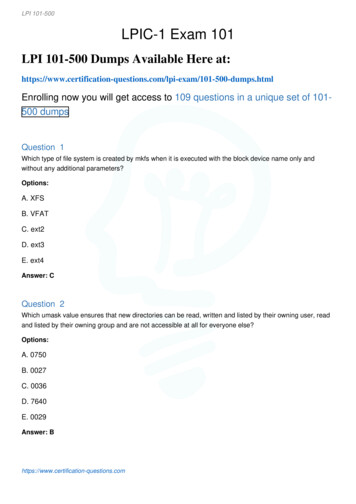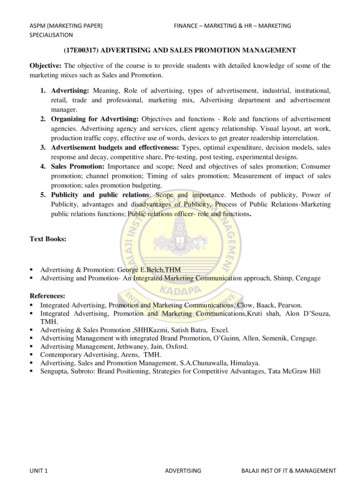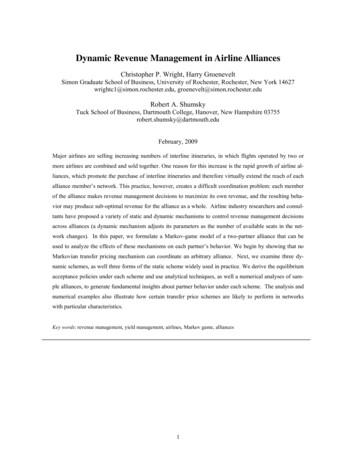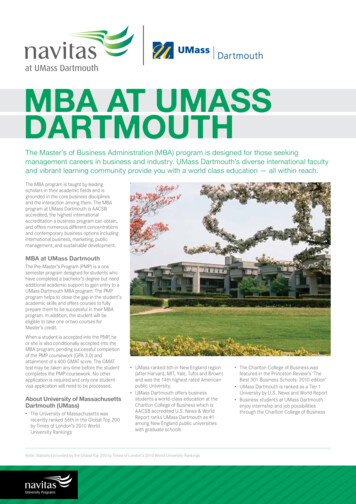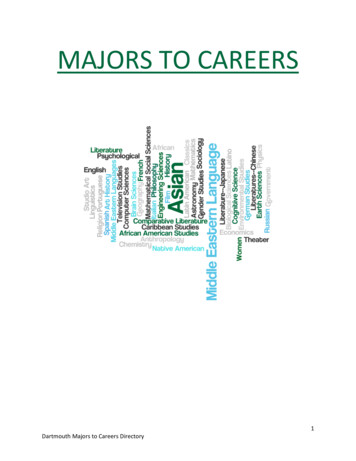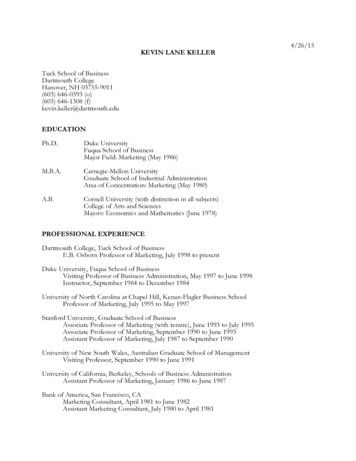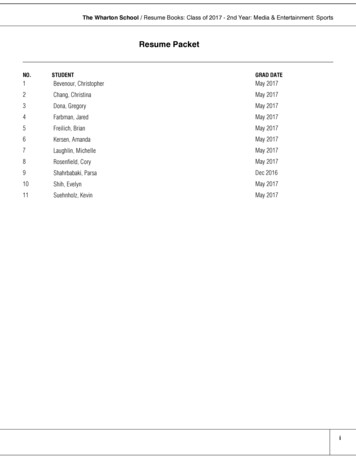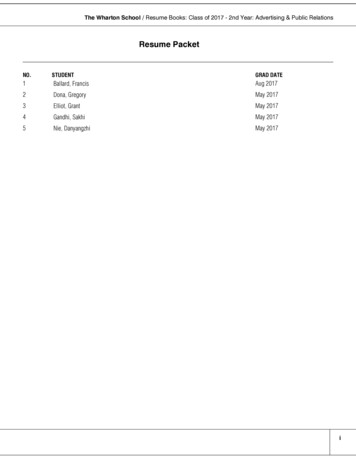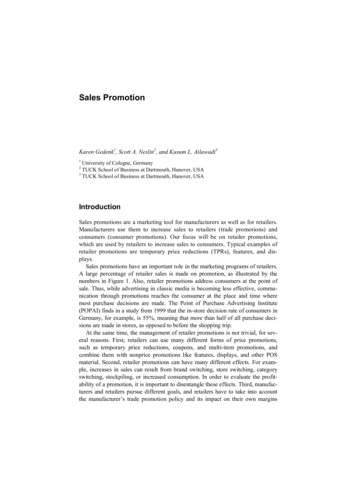
Transcription
Sales PromotionKaren Gedenk1, Scott A. Neslin2, and Kusum L. Ailawadi31University of Cologne, GermanyTUCK School of Business at Dartmouth, Hanover, USA3TUCK School of Business at Dartmouth, Hanover, USA2IntroductionSales promotions are a marketing tool for manufacturers as well as for retailers.Manufacturers use them to increase sales to retailers (trade promotions) andconsumers (consumer promotions). Our focus will be on retailer promotions,which are used by retailers to increase sales to consumers. Typical examples ofretailer promotions are temporary price reductions (TPRs), features, and displays.Sales promotions have an important role in the marketing programs of retailers.A large percentage of retailer sales is made on promotion, as illustrated by thenumbers in Figure 1. Also, retailer promotions address consumers at the point ofsale. Thus, while advertising in classic media is becoming less effective, communication through promotions reaches the consumer at the place and time wheremost purchase decisions are made. The Point of Purchase Advertising Institute(POPAI) finds in a study from 1999 that the in-store decision rate of consumers inGermany, for example, is 55%, meaning that more than half of all purchase decisions are made in stores, as opposed to before the shopping trip.At the same time, the management of retailer promotions is not trivial, for several reasons. First, retailers can use many different forms of price promotions,such as temporary price reductions, coupons, and multi-item promotions, andcombine them with nonprice promotions like features, displays, and other POSmaterial. Second, retailer promotions can have many different effects. For example, increases in sales can result from brand switching, store switching, categoryswitching, stockpiling, or increased consumption. In order to evaluate the profitability of a promotion, it is important to disentangle these effects. Third, manufacturers and retailers pursue different goals, and retailers have to take into accountthe manufacturer’s trade promotion policy and its impact on their own margins
304Karen Gedenk, Scott A. Neslin, and Kusum L. AilawadiGreat 0,05,010,015,020,025,030,0Percentage of Sales (in ) made on Promotion, January – June 2004Fig. 1. Percentage of Sales Made on Promotion in Europe (A.C.Nielsen)when planning their retailer promotions. Such initiatives as efficient consumer response (ECR) and collaborative planning, forecasting, and replenishment (CPFR)have tried to promote more cooperation between manufacturers and retailers, onearea of cooperation being sales promotions (see, e.g., chapter by Huchzermeier, Iyerin this book).Over the last 25 years a large research effort has been spent on studying the effects of promotions. Methods for measuring the success of promotions have beendeveloped and refined. And many substantive results have been accumulated,allowing us to make some empirical generalizations.At the beginning of the 21st century, promotions are facing new opportunitiesand challenges as technology plays an increasing part in retailing. Technologiessuch as loyalty cards, electronic media at the point of sale, and electronic shoppingassistants are likely to have an impact on how retailers use promotions, e.g. toallow better targeting of consumers.The purpose of this chapter is twofold. First, we want to review what we knowabout promotions as retailers have used them in the past. Second, we want to discuss the opportunities and challenges for promotions presented by new technologies in retailing.The chapter is divided up as follows. In the second section, we categorize anddescribe promotion instruments that retailers may use. In the third, we give anoverview of the effects of retailer promotions on sales and present empirical resultsas to the strength of these effects. We describe new technologies used in retailingand discuss the resulting opportunities and challenges for promotions in the fourthsection.
Sales Promotion305PromotionPrice promotionsNonprice promotions"Supportive"- TPR- Promotion packs- Loyalty discounts- Coupons- Rebates- Others- Promotion communication Features POS advertising Advertising in other media- Displays- POS materials- Promotion packaging- Others"True"- Sampling- Premiums- Sweepstakes/ contests- Events- OthersFig. 2. Instruments for Retailer PromotionsPromotion InstrumentsFigure 2 shows different promotion instruments that retailers may use (Gedenk2002, Neslin 2002).A first distinction can be made between price and nonprice promotions. The pricepromotion instrument used most often is a temporary price reduction (TPR). However, other forms of price promotion are possible. Retailers can use promotion packs,i.e., packages with extra content (e.g., “25 % extra”), or multi-item promotions (e.g.,“buy three for x” or “buy two get one free”). Loyalty discounts also require the purchase of several units, but the consumer can do this over several purchase occasions.Retailers can also use coupons or rebates. With coupons, consumers have to bringthe coupon to the store in order to get a discount. With rebates, consumers pay thefull price, but they can then send in their receipt to get a discount.“Supportive” nonprice promotions are communication instruments used to alertthe consumer to the product or to other promotion instruments. Very often they areused to draw attention to price promotions. For example, products on TPR arefeatured or displayed. Thus, the focus is not so much on the brand as on price.Note that they can also be used without a price promotion. For example, a featurecan advertise an everyday low price policy or a new product. Interestingly, there isevidence that consumers may interpret supportive nonprice promotions as a signalfor a price cut even if they are not coupled with actual price discounts, since thetwo are closely linked in many consumers’ minds.Finally, retailers can use “true” nonprice promotions, where the focus of thepromotion is clearly on a brand or store, and not on a price cut. However, instruments such as sampling and premiums are mostly used by manufacturers, and notby retailers. Therefore, our focus in the following will be on price and supportivenonprice promotions.
306Karen Gedenk, Scott A. Neslin, and Kusum L. AilawadiEffects of PromotionsOverview of EffectsTo assess the profitability of retailer promotions, retailers have to take into account their costs, the trade promotion allowances given to them, and the effect ofpromotions on sales to consumers (for more discussion on this point, see chapterby Bolton, Shankar and Montoya in this book). The biggest challenge for controllers lies in assessing the sales effects. Thus, we will discuss these in this section.Figure 3 shows the effects of a retailer promotion on the sales of the promotedproduct (Gedenk 2002, Neslin 2002).In Figure 3, we distinguish between short-term effects, which occur during thepromotion, and long-term effects, which involve behavior that takes place after thepromotion. Sales for the promoted brand can increase during the promotion byattracting customers from other stores (store switching), inducing customers toswitch brands (brand switching), inducing customers to buy from the promotedcategory rather than another category (category switching), inducing customerswho normally do not use the product category to purchase it (new users), or inducing customers to move their purchases forward in time (purchase acceleration).Purchase acceleration can occur because consumers purchase earlier or becausethey purchase more than they would have done without the promotion. Consumerscan either stockpile the extra quantity for future use or consume it at a faster rate.Total category consumption can also increase owing to category switching or ifthe promotion attracts new users.While the short-term sales bump will be highest if all these mechanisms are atwork, the particular breakdown of the bump into these mechanisms is importantfor the profitability of the promotion. Therefore, a controller must not stop atSales of thepromoted tswitchingStoreBrand Categoryswitching switching switchingLong-termeffectsProductloyaltyNew Consump- Stock- Brand Category Storeusers tion rate piling loyalty loyalty loyaltyFig. 3. Effects of Retailer Promotions
Sales Promotion307measuring the size of the short-term sales bump. Rather, it is important to analyzethis bump. An increase in category consumption resulting from new users, category switching, or a higher consumption rate is beneficial for both retailers andmanufacturers. If the bump is caused by consumer store switching, this is beneficial only to the retailer. Note there are two types of store switching—direct andindirect. A direct store switch is seen when the consumer visits store A rather thanstore B. An indirect store switch is when the consumer shops at both stores, butthe promotion in store A pre-empts a purchase that would otherwise have occurredat store B. Either form of store switching is beneficial to the retailer.In contrast, the part of the promotion bump that results from brand switchingwithin the store is good for the manufacturer, but not necessarily for the retailer.The effect on the retailer’s profit depends on which product has the higher margin—the product switched to or the product switched from. Accelerated purchasesthat are stockpiled for future use may or may not be beneficial to the retailer. Ifretailer profit margin during the promotion period is larger than that during thenonpromotion period, it is to the advantage of the retailer to encourage stockpiling. This may be why retailers sometimes use promotion signage such as “stockup and save.” If, however, the retailer’s promotional margin is smaller than theregular margin stockpiling is unprofitable for the retailer.In short, measuring the size of the short-term bump in sales actually says verylittle about whether the promotion is successful from the retailer’s point of view.The bump must be broken down as far as possible into the effects shown inFigure 3, and the retailer’s regular and promotional margins must be taken intoaccount.In addition to increases in short-term sales, promotions can have an effect onlong-term sales. Consumer stockpiling increases sales during the promotion, butdecreases them afterwards. Also, consumer loyalty may change. Manufacturershope for increased brand loyalty, while retailers would like to increase store loyalty. However, promotions may also have a negative effect on loyalty. Price promotions can decrease consumers’ reference prices, thus making the brand / storeappear expensive on the next shopping trip. Attribution theory and behaviorallearning theory explain how consumers can learn from buying on promotion, butthese theories cannot predict whether consumers learn to buy a certain brand / in acertain store, or whether they learn to purchase on promotion.Finally, a retailer is not only interested in sales of the promoted product, butalso in sales of other products in the store. Promotions are very favorable for aretailer if they draw consumers into the store, who then also purchase nonpromoted products. This can only occur if store switching is direct and the storeswitching consumers are not just cherry picking. If store switching is indirect,consumers shop at both store A and store B, and this is not changed by the promotion in store A. If store switching is direct but the store switchers are cherry pickers, then they only come to the store to buy the promoted product, so that sales ofother products do not increase.
308Karen Gedenk, Scott A. Neslin, and Kusum L. AilawadiWhat We Know About the Strength of Promotion EffectsMany researchers have developed methods of measuring the effects of promotionson sales and applied them to generate substantive results over the last 25 years.Most of these studies are based on scanner data and study fast-moving consumergoods sold in grocery stores. Some studies use store-level scanner data, whichhave the advantage of being readily available for managers. However, singlesource scanner panel data, which combine household and store data, allow a moredetailed analysis of promotion effects. With single-source data, researchers can gobeyond sales or market share response functions and investigate consumer behavior, such as store choice, category purchase incidence, brand choice, and purchasequantity in more detail. Therefore, many empirical studies are based on this typeof data. All these studies, together with laboratory and field experiments, havegenerated a wealth of results (for reviews see Gedenk 2002, Neslin 2002).Short-Term EffectsRetailer promotions typically cause a large bump in short-term sales of the promoted brands. Increases in sales by several hundred percent are not unusual. Promotional price elasticities differ across categories and depending on the promotioninstruments used. For example, Narasimhan, Neslin, and Sen (1996) find thatpromotional elasticities are higher for categories with a relatively small number ofbrands, shorter interpurchase times, and higher consumer propensity to stockpile.Supportive nonprice promotions can be used to enhance the effects of pricepromotions by drawing attention to them. For example, Narasimhan, Neslin, andSen (1996) report on the basis of an Information Resources, Inc., study that a 15%“unsupported” price cut yields an average sales increase of 34% across 108 categories, whereas a 15% price cut supported by a feature generates a 161% increase,and a 15% price cut supported by a display generates a 293% increase. Supportivenonprice promotions can also serve the purpose of framing the deal. After all, aprice promotion is like a picture—it looks different depending on which frame youput around it. Possible frames are external reference prices (e.g., “normally 3.99 —today only 2.99 ”) or price cuts expressed in percent (“25% off”) rather thanin absolute terms (“1 off”). Sometimes these frames can have strong effects,which result from simply putting up a sign. For example, Wansink, Kent, andHoch (1998) show in a field experiment that imposing a quantity limit for cannedsoup [“limit of 4 (12) per person”] increases the average quantity bought per person. Given that consumers who would have bought a very large quantity withoutthe promotion are not allowed to do so, a decrease in average quantity would havebeen expected. The authors explain their surprising results with an anchoring andadjustment effect. Consumers use the number in the quantity limit as an anchor toadjust their purchase quantity upwards. Another explanation could be that consumers interpret the quantity limit as a signal for a particularly attractive promotion. Finally, supportive nonprice promotions can be used by themselves without a
Sales Promotion309price reduction. Often consumers interpret promotional signs and displays in thestores as a signal for a promotion, resulting in an increase in sales at full margin.In summary, then, not only do price reductions matter, but POS signage, displays,and features can have a large impact on sales and profit contribution.Many researchers have broken down the short-term sales bump into brandswitching and purchase acceleration components. Until recently, empirical analyses seemed to indicate that about three quarters of the sales bump results frombrand switching. However, van Heerde, Gupta, and Wittink (2003) have pointedout that these studies, which are based on a breakdown of the elasticity, have beeninterpreted in an inadequate way. When van Heerde, Gupta, and Wittink performed a unit sales decomposition and look at how much the promoted brandgains and how much competitors lose in sales, they found that two thirds of thesales bump resulted from purchase acceleration and only one third from brandswitching. Other authors have shown that purchase acceleration can translate intoadditional category consumption through a faster use-up rate. For example, Ailawadi and Neslin (1998) find that 13% of the short-term sales bump for yogurt isdue to increased consumption, whereas in the case of ketchup increased consumption accounts for only 5%. In summary, then, we know that promotions causesubstantial purchase acceleration, which, at least in some categories, can result inincreased consumption.The most important promotion effect for a retailer, store switching, has notbeen studied as much, and the empirical evidence of it that exists is somewhatmixed. A few studies find no effect of promotions on store traffic and store sales,but these studies use store-level data from supermarkets that run promotions everyweek, so that they can only study differences between the promotion bundles advertised each week. Other studies do indicate that promotions increase store traffic(e.g., Lam et al. 2001) and that a substantial part of the category expansion withinthe store comes from store switching (e.g., van Heerde, Leeflang and Wittink2004). The latter study finds that, on average across different types of promotions,store switching accounts for 25% of the sales bump for tissues and 34% for peanutbutter. The effect is about as strong for unfeatured as for featured promotions,indicating that a lot of the store switching must be indirect. More support for indirect store switching is provided by Bucklin and Lattin (1992), who studied singlesource scanner panel data for detergent. They find no evidence for direct storeswitching from features, but an increase in market share of the store in the promoted category, resulting from indirect store switching.Even less is known about the extent of category switching that is attributable topromotions. One cross-category effect that has been studied extensively is category complementarity, that is, whether promotions in category A can increasesales in category B if the products are used or purchased together by the consumer. For example, Mulhern and Leone (1991) find sales increases for relatedproducts in some grocery categories, but not in others. They also find that if crosscategory relationships exist, they are asymmetrical. For example, cakemix pricessignificantly affect frosting sales, but the reverse is not true. Mulhern and Padgett
310Karen Gedenk, Scott A. Neslin, and Kusum L. Ailawadi(1995) matched actual purchases of consumers with survey data to study the effectof promotions on nonpromoted products. In this study, only 23.2% of consumerswho indicated that they had come to the store because of a promotion bought onlythe promoted item. This means that cherry picking exists, but not to a very largeextent. At the same time, 51.8% of the consumers who had come to the store because of the promotion bought only nonpromoted items. Mulhern and Padgett findthat this is not because the promoted product is out of stock, but because manyconsumers change their plans once they come to the store, or are disappointed bythe promoted item when they inspect it. Note that Mulhern and Padgett found thiseffect in a home improvement store. In grocery retailing, where products are wellknown, it seems less likely that many consumers will visit the store because of apromotion but then not buy the promoted product. In summary, then, there is someevidence for positive effects of promotions on nonpromoted products, but it is notvery strong. This issue certainly warrants further investigation.Long-Term EffectsMany researchers have studied the effect of promotions on brand loyalty. Theyfind that temporary price cuts decrease reference prices, increase price sensitivity,and decrease share of category requirements and repurchase probabilities. Thesefindings suggest a negative relationship between promotion and brand loyalty.However, the net effect on brand sales may be positive, at least for some customers. The reason is that consumers show some inertia in their purchase patterns:they tend to repurchase what they purchased last time. A promotion makes it morelikely for this inertial effect to occur, because it induces that first purchase.Promotion weakens the inertial effect relative to a nonpromotion purchase, but theinertial effect is still positive. As a result, promotions do not necessarily decreaselong-term market share (Gedenk, Neslin 1999). In fact, the net impact on sharecan be positive. Ailawadi, Lehmann and Neslin (2001) find that, in the long run,decreasing promotion and, as a result, increasing net price had a detrimental effecton customer share of requirements and contributed to a decrease in market share.In addition, Gedenk and Neslin (1999) find that nonprice promotions such as features and sampling have a weaker short-term effect, but are more favorable forbrand loyalty than are price promotions, resulting in a stronger positive net effecton brand choice probabilities after the promotion.Unfortunately, the effect of promotions on store loyalty has not been studied asmuch. An important measurement issue with regard to store loyalty is whetherinherently nonloyal shoppers are self-selected to shop at promotion-orientedstores, or whether promotions in fact erode the loyalty of shoppers over time. Belland Lattin (1998) provide some evidence of a self-selection effect. They show thatconsumers who purchase large total market baskets per visit tend to favor storesthat feature everyday low pricing (EDLP), whereas shoppers who purchase smallmarket baskets prefer stores that run good promotions. Sirohi, McLaughlin andWittink (1998) find that perceptions of a store’s promotions correlate positively
Sales Promotion311with perceived value and store loyalty. Finally, Taylor, Neslin (2005) provideevidence for a positive effect of a special type of promotion on store loyalty. Theystudied a loyalty promotion in which consumers could obtain a free turkey productbased upon purchases during an 8-week promotion period. They found that thisreward program increased sales during the 8 weeks of the promotion (“pointspressure effect”). In addition, consumers participating in the promotion purchasedmore in the store after the promotion. This “rewarded behavior effect” occursbecause the goodwill and positive affect created by the reward resulted in the customer having a more favorable view of the retailer and hence purchasing more. Insummary, there is some evidence that promotions can have a positive effect onstore loyalty, but the issue warrants further investigation.Future DevelopmentsNew TechnologiesRetailing is currently facing opportunities from a variety of new technologies. InGermany, Metro is currently testing many of these technologies in its “FutureStore,” grocery store belonging to the “Extra” chain in Rheinberg. In this paper wewill not discuss all of these technologies, but just briefly present those that weexpect to have the largest impact on promotions: Loyalty cards Personal shopping assistants (PSA) Electronic shelf labels and advertising displays RFIDLoyalty CardsLoyalty cards have been used by retailers for quite a few years. Nonetheless, theyare still included here, since they can be combined with some of the other technologies and they constitute a major basis for targeting promotions. Metro in Germany isa participant in the “Payback,” loyalty program administered by the company Loyalty Partners. Consumers can collect Payback points in many Metro stores, such asReal (grocery), Kaufhof (department store), and OBI (DIY), but also in chains ofother retailers, such as Apollo Optik (optician) and Goertz (shoes). Once consumershave collected a certain number of points they can exchange them for a cash payment or a premium. In September 2004, Payback had issued as many as 28.3 millioncards to consumers in Germany (the chapter by Reinartz in this book provides moreinformation on the design of loyalty programs).For Metro, Payback provides valuable data for promotion analysis and planning. As in a single-source panel, the retailer has data on consumer purchase be-
312Karen Gedenk, Scott A. Neslin, and Kusum L. Ailawadihavior at the household level, as well as in-store data on the promotion environment at the time when purchases are made. One disadvantage relative to singlesource data is that loyalty card data only concern purchases within the participating chains of stores. Thus, purchases made in a competitor’s store cannot be registered. Note also that Payback only provides detailed data for consumers who haveacquired their card through a certain chain of stores. Owing to privacy regulations,the rest of the raw Payback data is only available to Loyalty Partners. It can nonetheless be used for targeting consumers, since direct mail promotions, for example, can be sent through Loyalty Partners.Personal Shopping AssistantsPersonal shopping assistants (PSAs) can be attached to customers’ shopping cartswhen they enter a store. At the Metro Future Store, the PSA reads the Paybackcard of a shopper, so that it can access the purchase history of the customer’shousehold. The PSA display shows an electronic shopping list. It initially proposes a shopping list based on the favorites from previous purchases. The consumer can than modify that list. If the consumer scans the products s/he puts intothe shopping car, the PSA calculates total price and indicates savings from products bought at a reduced price (see also chapter by Litfin and Wolfram in thisbook). In addition, the PSA displays information on promotions in the store. PSAstherefore offer the potential to induce category complementarity and encouragenew use, indirect store switching, and purchase acceleration effects.Electronic Shelf Labels and Advertising DisplaysElectronic shelf labels and advertising displays are controlled centrally by WLAN.In the Metro Future Store, electronic shelf labels are directly connected to theprice administration system and the checkout system. Thus, prices on the shelvesare always identical to prices at the checkout. On LCD displays the labels showthe prices of products on the shelf. In addition, special offers may be highlightedby a flashing signal.Electronic advertising displays are attached to the ceiling in several locations inMetro’s Future Store. They can display advertising messages or show videos.Messages can be changed within seconds. This type of signage might be veryeffective at inducing profitable brand switching and indirect store switching aswell as new use and purchase acceleration effects (see, e.g., chapter by Kalyanam,Lal, and Wolfram in this book for more detail on technologies being used inMetro’s Future Store).Radio Frequency IdentificationFinally, an important new technology in retailing is radio frequency identification (RFID). This auto-identification technology uses radio waves to identifyindividual physical objects. In the US, WalMart is the first to have asked its
Sales Promotion313suppliers to attach RFID tags to pallets and cases of products. In Germany,Metro is a pioneer in the usage of RFID. In its Future Store, it is even runningtests with tags attached to individual products. So far, this is an expensive exercise, since each tag costs about 30 cents. Also, RFID is still beset with technicalproblems, such as the receivers’ inability to read through liquid and metal. Finally, consumers have strong concerns about privacy. This has induced the Future store to test deactivating devices, which make sure that RFID tags can nolonger be read once the consumer leaves the store. In spite of these current difficulties, many experts expect RFID to develop further and replace identificationthrough UPC / EAN in the future.So far, tests of RFID have focused on optimizing the supply chain, and reducing costs in logistics. But RFID also offers potential for servicing the customerbetter, particularly when tags are attached to individual products, and for betteranalyses of the impact of retailers’ in-store merchandising activity.Opportunities for Sales PromotionsThe technologies described above can be expected to affect retailer promotions inseveral ways, the most important ones of which are related to: Better control Targeting consumers outside the store Targeting consumers in the store Cross-sellingWe will discuss these aspects in turn.Better ControlA first effect of the new technologies is increased flexibility with respect to pricechanges. In particular, electronic shelf labels and electronic displays allow theretailer to adjust prices very quickly. Thus, it becomes possible to run promotionsfor very short time spans. For example, a retailer could offer a price promotionduring the day, when most housewives go shopping, and return to the regular priceat night, when many singles shop after their working day is finished. This meansthat promotions will have an increased potential for price discrimination.Also, promotions in a traditional retail environment often run into problemswith out-of-stocks. Since it is hard to forecast sales bumps caused by a promotion,retailers may not have enough of the promoted product in the shelf or display, andthus not be able to satisfy consumers’ demand. RFID technology may help discover out-of-stocks very quickly, so that extra products can be moved to the pointof-sale (see chapter by Verhoef and Sloot in this book for more information onevolving approaches to out-of-stocks reduction).
314Karen Gedenk, Scott A. Neslin, and Kusum L. AilawadiTargeting Consumers Outside the StorePrice promotions are an important tool in price discrimination. Typically, the pricediscrimination works through self-selection of the consumers. The promotion isoffered to all customers, who then decide whether to use it or not. However, promotions can be an even stronger mechanism for price discrimination if retailers donot offer them to all customers, but target certain consumers. This type of targeting can be an effective way of encouragin
Sales Promotion Karen Gedenk1, Scott A. Neslin2, and Kusum L. Ailawadi3 1 University of Cologne, Germany 2 TUCK School of Business at Dartmouth, Hanover, USA 3 TUCK School of Business at Dartmouth, Hanover, USA Introduction Sales promotions are a marketing tool for manufacturers as well as for retailers. Manufacturers use them to increase sales to retailers (trade promotions) and
